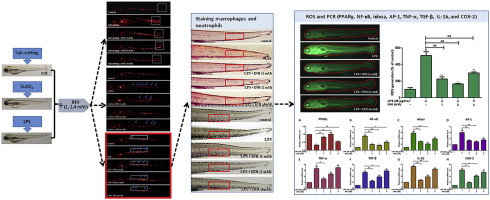当前位置:
X-MOL 学术
›
Chem. Biol. Interact.
›
论文详情
Our official English website, www.x-mol.net, welcomes your feedback! (Note: you will need to create a separate account there.)
Isoniazid promotes the anti-inflammatory response in zebrafish associated with regulation of the PPARγ/NF-κB/AP-1 pathway.
Chemico-Biological Interactions ( IF 5.1 ) Pub Date : 2019-12-16 , DOI: 10.1016/j.cbi.2019.108928 Yun Zhang 1 , Chao Wang 2 , Zhi-Li Jia 1 , Rui-Jiao Ma 1 , Xue-Fang Wang 3 , Wei-Yun Chen 4 , Ke-Chun Liu 1
Chemico-Biological Interactions ( IF 5.1 ) Pub Date : 2019-12-16 , DOI: 10.1016/j.cbi.2019.108928 Yun Zhang 1 , Chao Wang 2 , Zhi-Li Jia 1 , Rui-Jiao Ma 1 , Xue-Fang Wang 3 , Wei-Yun Chen 4 , Ke-Chun Liu 1
Affiliation

|
OBJECTIVE
Zebrafish inflammation models were used to evaluate the anti-inflammatory activity of isoniazid (INH) and preliminarily investigate the underlying mechanism.
METHODS
Local, acute, and systemic zebrafish inflammation models were established by tail cutting, copper sulfate (CuSO4), and lipopolysaccharide (LPS) endotoxin treatments, respectively, to evaluate the anti-inflammatory activity of INH. Zebrafish in the inflammatory state were exposed to different concentrations of INH (1, 2, and 4 mM) for 72 h to observe changes in the migration and accumulation of inflammatory cells and measure the reactive oxygen species (ROS) content in zebrafish after INH treatment. The transcription levels of inflammation-related genes in zebrafish from all groups were measured using real-time polymerase chain reaction (RT-PCR).
RESULTS
Compared to those observed in the control inflammation model group, the numbers of migrated and accumulated inflammatory cells in zebrafish in the INH-treated group significantly decreased. INH significantly decreased the ROS content induced by LPS. Compared to that observed in the LPS model group, INH at 1 and 2 mM significantly increased the expression of PPARγ and inhibited the expression of NF-κB, iκbαa, and AP-1 as well as the inflammatory factors TNF-ɑ, TGF-β, IL-1b, and COX-2.
CONCLUSION
In this study, different zebrafish inflammation models were used to confirm that INH has anti-inflammatory activity. The associated mechanism may occur through the inhibition of ROS release, activation of PPARγ expression, inhibition of the transcriptional regulatory activity of NF-κB and AP-1, and reduction of INH inflammatory factor expression to relieve inflammation. The results of this study provide references for the clinical application of INH.
中文翻译:

异烟肼促进斑马鱼的抗炎反应,与PPARγ/NF-κB/ AP-1途径的调节有关。
目的使用斑马鱼炎症模型评估异烟肼(INH)的抗炎活性,并初步研究其潜在机制。方法分别通过截尾,硫酸铜(CuSO4)和脂多糖(LPS)内毒素处理建立局部,急性和全身性斑马鱼的炎症模型,以评估INH的抗炎活性。将处于炎性状态的斑马鱼暴露于不同浓度的INH(1、2和4 mM)72小时,以观察炎性细胞迁移和积累的变化并测量INH处理后斑马鱼中的活性氧(ROS)含量。使用实时聚合酶链反应(RT-PCR)测量了所有组中斑马鱼中与炎症相关的基因的转录水平。结果与对照组炎症模型组相比,INH治疗组斑马鱼中炎性细胞迁移和积累的数量明显减少。INH显着降低了LPS诱导的ROS含量。与LPS模型组相比,INH在1和2 mM时显着增加PPARγ的表达,并抑制NF-κB,iκbαa和AP-1以及炎性因子TNF-ɑ,TGF-β的表达。 ,IL-1b和COX-2。结论在这项研究中,使用不同的斑马鱼炎症模型来确认INH具有抗炎活性。可能通过抑制ROS释放,激活PPARγ表达,抑制NF-κB和AP-1的转录调节活性来发生相关机制。减少INH炎性因子的表达以减轻炎症。本研究结果为INH的临床应用提供参考。
更新日期:2019-12-17
中文翻译:

异烟肼促进斑马鱼的抗炎反应,与PPARγ/NF-κB/ AP-1途径的调节有关。
目的使用斑马鱼炎症模型评估异烟肼(INH)的抗炎活性,并初步研究其潜在机制。方法分别通过截尾,硫酸铜(CuSO4)和脂多糖(LPS)内毒素处理建立局部,急性和全身性斑马鱼的炎症模型,以评估INH的抗炎活性。将处于炎性状态的斑马鱼暴露于不同浓度的INH(1、2和4 mM)72小时,以观察炎性细胞迁移和积累的变化并测量INH处理后斑马鱼中的活性氧(ROS)含量。使用实时聚合酶链反应(RT-PCR)测量了所有组中斑马鱼中与炎症相关的基因的转录水平。结果与对照组炎症模型组相比,INH治疗组斑马鱼中炎性细胞迁移和积累的数量明显减少。INH显着降低了LPS诱导的ROS含量。与LPS模型组相比,INH在1和2 mM时显着增加PPARγ的表达,并抑制NF-κB,iκbαa和AP-1以及炎性因子TNF-ɑ,TGF-β的表达。 ,IL-1b和COX-2。结论在这项研究中,使用不同的斑马鱼炎症模型来确认INH具有抗炎活性。可能通过抑制ROS释放,激活PPARγ表达,抑制NF-κB和AP-1的转录调节活性来发生相关机制。减少INH炎性因子的表达以减轻炎症。本研究结果为INH的临床应用提供参考。



























 京公网安备 11010802027423号
京公网安备 11010802027423号